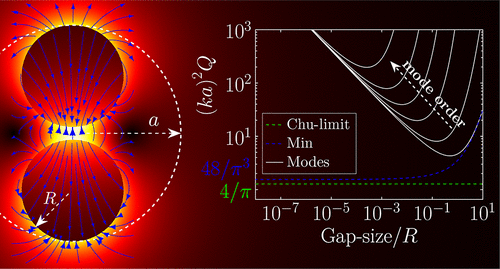当前位置:
X-MOL 学术
›
ACS Photonics
›
论文详情
Our official English website, www.x-mol.net, welcomes your feedback! (Note: you will need to create a separate account there.)
Bandwidth of Singular Plasmonic Resonators in Relation to the Chu Limit
ACS Photonics ( IF 7 ) Pub Date : 2021-10-25 , DOI: 10.1021/acsphotonics.1c01084 Mariano Pascale 1, 2 , Sander A. Mann 2 , Carlo Forestiere 1 , Andrea Alù 2, 3
ACS Photonics ( IF 7 ) Pub Date : 2021-10-25 , DOI: 10.1021/acsphotonics.1c01084 Mariano Pascale 1, 2 , Sander A. Mann 2 , Carlo Forestiere 1 , Andrea Alù 2, 3
Affiliation

|
Plasmonic nanostructures with singular geometries can exhibit a broadband scattering response that at first glance appears to violate the lower bounds for the radiation quality (Q) factor of small radiators, known as the Chu limit. Here we explore this apparent contradiction, investigating the Q factor of the resonant modes supported by two nearly touching cylinders, and analyze how their fractional bandwidth fares in relation to the Chu limit. We first derive lower bounds for the radiation Q factors of two-dimensional objects of an arbitrary cross-section. We then discuss the dissipation and radiation Q factors associated with the plasmonic resonances of a cylinder dimer as a function of its gap size. We show that the radiation Q factor is always larger than the minimum Q and, as long as the peaks in the scattering spectrum are well separated, their bandwidth is equal to the inverse of their Q factor. In the limit of touching cylinders, the resonance spectra transition from discrete to a continuum around an accumulation point, yielding a broadband response for any finite level of material loss. Within any given frequency interval, the response is the result of a multitude of plasmon resonances, each individually obeying the Chu limit. Nevertheless, the connection between the Q factor and the overall bandwidth of the scattering response is lost. Our study sheds light onto the exotic resonant phenomena emerging when plasmonic materials are shaped in singular geometries, and outlines their opportunities and limitations for nanophotonics.
中文翻译:

与 Chu 极限有关的奇异等离子体谐振器的带宽
具有奇异几何形状的等离子体纳米结构可以表现出宽带散射响应,乍一看似乎违反了小辐射器的辐射质量 ( Q ) 因子的下限,即 Chu 极限。在这里,我们探讨了这个明显的矛盾,研究了由两个几乎接触的圆柱体支持的谐振模式的Q因子,并分析了它们的分数带宽与 Chu 极限的关系。我们首先推导出任意横截面的二维物体的辐射Q因子的下限。然后,我们讨论了与圆柱二聚体的等离子体共振相关的耗散和辐射Q因子,作为其间隙大小的函数。我们证明辐射Q因子始终大于最小Q 值,并且只要散射光谱中的峰分离良好,它们的带宽就等于其Q因子的倒数。在接触圆柱体的极限内,共振谱从离散到聚集点附近的连续谱过渡,对任何有限水平的材料损失产生宽带响应。在任何给定的频率间隔内,响应是大量等离子体共振的结果,每个共振都单独遵守 Chu 限制。然而,Q之间的联系因子和散射响应的总带宽丢失。我们的研究揭示了当等离子体材料以奇异几何形状成形时出现的奇异共振现象,并概述了它们对纳米光子学的机会和局限性。
更新日期:2021-11-17
中文翻译:

与 Chu 极限有关的奇异等离子体谐振器的带宽
具有奇异几何形状的等离子体纳米结构可以表现出宽带散射响应,乍一看似乎违反了小辐射器的辐射质量 ( Q ) 因子的下限,即 Chu 极限。在这里,我们探讨了这个明显的矛盾,研究了由两个几乎接触的圆柱体支持的谐振模式的Q因子,并分析了它们的分数带宽与 Chu 极限的关系。我们首先推导出任意横截面的二维物体的辐射Q因子的下限。然后,我们讨论了与圆柱二聚体的等离子体共振相关的耗散和辐射Q因子,作为其间隙大小的函数。我们证明辐射Q因子始终大于最小Q 值,并且只要散射光谱中的峰分离良好,它们的带宽就等于其Q因子的倒数。在接触圆柱体的极限内,共振谱从离散到聚集点附近的连续谱过渡,对任何有限水平的材料损失产生宽带响应。在任何给定的频率间隔内,响应是大量等离子体共振的结果,每个共振都单独遵守 Chu 限制。然而,Q之间的联系因子和散射响应的总带宽丢失。我们的研究揭示了当等离子体材料以奇异几何形状成形时出现的奇异共振现象,并概述了它们对纳米光子学的机会和局限性。



























 京公网安备 11010802027423号
京公网安备 11010802027423号